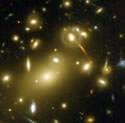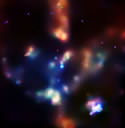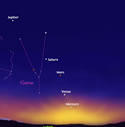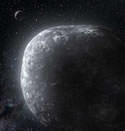
Image credit: Hubble
Recent evidence seems to indicate that the expansion of the Universe is actually accelerating – some kind of “dark energy” is pushing it apart. And a new redshift survey of galactic clusters seems to support this. Astronomers using data gathered by the Chandra X-Ray Observatory have determined that there is insufficient matter (both regular and dark matter) in various galactic clusters to account for their shape and position, so something else must be having an effect.
The universe appears to be permeated with an invisible force ? dark energy ? that is pushing it apart faster and faster. By conducting redshift surveys of galaxy clusters, astronomers hope to learn more about this mysterious force, and about the structure and geometry of the universe.
“Galaxy clusters consist of thousands of galaxies gravitationally bound into huge structures,” said Joseph Mohr, a professor of astronomy at the University of Illinois. “Because of the expansion of the universe, the clusters appear denser at larger redshifts, when the universe was younger and denser.”
Galaxy cluster surveys that probe the high-redshift universe can potentially provide a wealth of information about the amount and nature of both dark matter and dark energy, said Mohr, who will present the results of an ongoing study of galaxy clusters at a meeting of the American Physical Society, to be held in Albuquerque, N.M., April 20-23.
“Till now, galaxy clusters have only been used to study the dark matter component of the universe,” Mohr said. “We would measure the total mass in a galaxy cluster, and then determine the fraction of mass that was ordinary, baryonic matter.”
Those measurements have shown there is insufficient baryonic and dark matter to account for the geometry of the universe. Astronomers now believe the universe is expanding at ever-increasing speed, and is dominated by a mysterious dark energy that must be doing the pushing.
“The next step is to try to figure out some of the specifics of the dark energy, such as its equation of state,” Mohr said. “By mapping the redshift distribution of galaxy clusters, we should be able to measure the equation of state of dark energy, which would provide some important clues to what it is and how it came to be.”
Mohr is using data collected by NASA’s Chandra X-ray Observatory to study scaling relations ? such as the relationship between mass and luminosity or size ? of galaxy clusters and how they change with redshift. “These scaling relations are expected to evolve with redshift, reflecting the increasing density of the universe at earlier times,” Mohr said.
In particular, Mohr ? in collaboration with John Carlstrom at the University of Chicago and scientists at the University of California and Harvard Smithsonian Center for Astrophysics ? is studying the effect that hot electrons within galaxy clusters have on the cosmic microwave background, the afterglow of the big bang.
Galaxy clusters are filled with dark matter, galaxies and hot gas. Electrons in the gas scatter off the protons and produce X-rays. The emission of X-rays diminishes with higher redshift, because of the larger distances involved.
“There also is a tendency for the electrons to give some of their energy to the photons of the cosmic microwave background, which causes the blackbody spectrum to shift slightly,” Mohr said. “The resulting distortion ? called the Sunyaev-Zeldovich effect ? appears as a cold spot on the cosmic microwave background at certain frequencies. Because this is a distortion in the spectrum, however, it doesn’t dim with distance like X-rays.”
By comparing the X-ray emission and the Sunyaev-Zeldovich effect, Mohr can study even faint, high-redshift galaxy clusters that are currently inaccessible by other means. Such measurements, correlating galaxy cluster redshift distribution, structure and spatial distribution, should determine the equation of state of dark energy and, therefore, help define the essence of dark energy.
“Within the context of our standard structure formation scenario, galaxy surveys provide measurements of the geometry of the universe and the nature of the dark matter and dark energy,” Mohr said. “But, to properly interpret these surveys, we must first understand how the structure of galaxy clusters are changing as we look backward in time.”
Original Source: UIUC News Release





